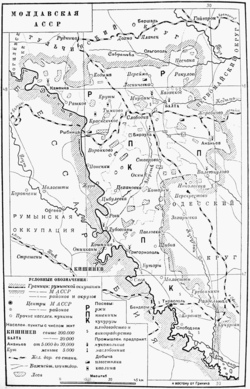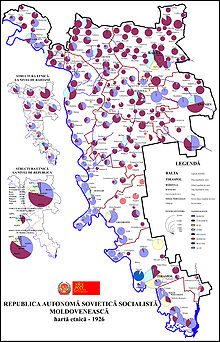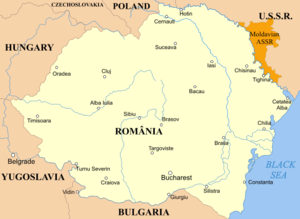- Moldavian Autonomous Soviet Socialist Republic
-
Moldavian Autonomous Soviet Socialist Republic ← 
1924–1940  →
→
 →
→Motto
Russian: Пролетарии всех стран, соединяйтесь!
Ukrainian: Пролетарі всіх країн, єднайтеся!
"Moldavian/Romanian:" Пролетарь дин тоате цэриле, униць-вэ! Proletari din toate ţările, uniţi-vă!Capital Balta (1924-1928)
Birzula (1928-1929)
Tiraspol (1929-1940)Language(s) Moldavian, Ukrainian, Russian Government Socialist republic History - Established 1924 - Disestablished 1940 Area - 1940 8.100 km2 (3 sq mi) Population - 1940 est. 572.339 Density 70.7 /km2 (183 /sq mi) Currency Ruble Today part of  Moldova
Moldova
 Ukraine
UkraineThe Moldavian Autonomous Soviet Socialist Republic (Moldavian/Romanian: Република Аутономэ Советикэ Cочиалистэ Молдовеняскэ, Republica Autonomă Sovietică Socialistă Moldovenească), shortened to Moldavian ASSR or, less frequently, Moldovan ASSR, was an autonomous republic of the Ukrainian SSR between 12 October 1924 and 2 August 1940, encompassing modern Transnistria (now in Moldova) and a number of territories that are now part of Ukraine.
Contents
Creation
The creation of the autonomous republic was initiated by a letter signed by Grigore Kotovski, Bădulescu Alexandru, Pavel Tcacenco, Solomon Tinkelman (Timov), Alexandru Nicolau, Alexandru Zalic, Ion Dic Dicescu (also known as Isidor Cantor), Theodor Diamandescu, Teodor Chioran, and Vladimir Popovici, all signatories being Bolshevik activists (many of them from Bessarabia). Establishing the republic became a matter of dispute. Soviet commissar of foreign relations Chicherin held that its establishment would be premature and would lead to the "expansion of Romanian chauvinism". On the other hand, Kotovski held that a new republic would spread Communist ideas into neighboring Bessarabia, with a chance that even Romania and the entire Balkan region would be revolutionized. On March 7, 1924, it was cautiously decided to create a Moldavian Autonomous Oblast within the Ukrainian SSR.
While the creation of ethnic-based autonomous republics was a general Soviet policy at that time, with the creation of the Moldavian ASSR, the Soviet Union also hoped to bolster its claim to Bessarabia.[1]
For the Soviets the republic was to be a way for winning over Bessarabians of Romania and the first step towards a revolution in Romania.[2] This purpose is explained in an article of the newspaper Odessa Izvestia in 1924, in which a Russian politician, Vadeev says that "all the oppressed Moldavians from Bessarabia look at the future Republic like at a lighthouse, which spreads the light of freedom and human dignity,"[3] as well as in a book published in Moscow, which claimed that "once the economic and cultural growth of Moldova has begun, aristocracy-led Romania will not be able to maintain its hold on Bessarabia."[4]
Geography
The Moldavian ASSR was created from a territory previously administered as part of the Odessa and Podolia regions of Ukraine. It accounted for 2% of the land and population of the Ukrainian SSR at the time.[5]
Initially, the oblast had four districts, all of them having a Moldovan majority:[6]
- Rîbniţa - 48,748 inhabitants, of which 25,387 Moldovans - 52%
- Dubăsari - 57,371 inhabitants, of which 33,600 Moldovans- 58%
- Tiraspol - almost entirely Moldovan
- Ananiv - 45,545 inhabitants, of which 24,249 Moldovans- 53%
On 8 October 1924 the oblast was elevated to the status of autonomous republic and included several other territories, including some with little Moldavian population, such as the Balta district (where the capital was located), which had only 2.52% Moldavians.
The official capital was proclaimed the "temporarily occupied city of Kishinev". Meanwhile, a provisional capital was established in Balta and moved to Tiraspol in 1929, where it remained until the MASSR was integrated into the newly created Moldavian SSR in 1940.[7]
Demographics
MASSR had a mixed Ukrainian (46%) and Moldovan (32%) population, which was estimated at 545,500. Its area was 8,677 km² and included 11 raions on the left bank of Dniester.
According to the 1926 Soviet census, the Republic had a population of 572,339,[8] of which:
Ethnic
groupcensus 1926 1936 Number % Number % Ukrainians 277,515 48.5% 265,193 45.5% Moldovans 172,419 30.1% 184,046 31.6% Russians 48,868 8.5% 56,592 9.7% Jews 48,564 8.5% 45,620 7.8% Germans 10,739 1.9% 12,711 2.2% Bulgarians 6,026 1.1% Poles 4,853 0.8% Roma (Gypsies) 918 0.2% Romanians 137 0.0% Other 2,300 0.4% 13,526 2.4% Total 572,339 582,138 Despite this extensive territory allotted to the Moldavian Autonomous Soviet Socialist Republic, about 85,000 Moldovans remained in Ukraine outside the territory of MASSR.[2]
History of Moldova 
This article is part of a seriesAntiquity Chernyakhov culture Dacia, Free Dacians Bastarnae Early Middle Ages Origin of the Romanians Tivertsi Brodnici Golden Horde Principality of Moldavia Foundation Stephen the Great Early Modern Era Phanariots United Principalities Bessarabia Governorate Treaty of Bucharest Moldavian Democratic Republic Sfatul Ţării Greater Romania Union of Bessarabia with Romania The Holocaust in Romanian-controlled territories Moldavian ASSR Moldovenism Moldavian SSR Soviet occupation of Bessarabia and Northern Bukovina Soviet deportations Republic of Moldova Independence of Moldova War of Transnistria History of independent Moldova
Moldova Portal
History
During the Russian Civil War, the area of the Moldavian ASSR switched hands twelve times between the White Movement, the Red Army, the Cossacks, Ukrainian militias and roving hordes of bandits. After the victory of the Bolsheviks, in 1920, it became part of the Ukrainian SSR.[5]
The area was quickly industrialized, and because of the lack of a qualified workforce, a significant migration from other Soviet republics occurred, predominantly Ukrainians and Russians. In particular, in 1928, of 14,300 industrial workers only about 600 were Moldovans.[citation needed]
In 1925 MASSR survived a famine.
In December 1927, the Time Magazine has reported a number of anti-Soviet uprisings among peasants and factory workers in Tiraspol and other cities (Mogilev-Podolskiy, Kamyanets-Podolskiy) of southern Ukrainian SSR. Troops from Moscow were sent to the region and suppressed the unrest, resulting in ca 4000 deaths. The insurrections were at the time completely denied by the official Kremlin press.[9]
Collectivization in the MASSR was even more fast-paced than in Ukraine and was reported to be complete by summer 1931. This was accompanied by the deportation of about 2,000 families to Kazakhstan.
In 1932-1933 another famine, known as Holodomor in Ukraine, occurred, with tens of thousands of peasants dying of starvation. During the famine, thousands of inhabitants tried to escape over the Dniester, despite the threat of being shot.[10] The most notable such incident happened near the village Olăneşti on February 23, 1932, when 40 persons were shot. This was reported in European newspapers by survivors. The Soviet side reported this as an escape of "kulak elements subverted by Romanian propaganda."
Promotion of Moldovan identity
Main article: Moldovenism The weekly newspaper Plugarul Roşu [The Red Ploughman] of the Moldavian ASSR began appearing on July 1, 1924
The weekly newspaper Plugarul Roşu [The Red Ploughman] of the Moldavian ASSR began appearing on July 1, 1924 Ukrainian SSR in 1933, after the Peace of Riga and the consolidation of USSR. Note the rose border line showing the Soviet claim over the former Russian Bessarabia Governorate
Ukrainian SSR in 1933, after the Peace of Riga and the consolidation of USSR. Note the rose border line showing the Soviet claim over the former Russian Bessarabia Governorate
The tenet that the Moldavian language is distinct from the Romanian language was heavily promoted in the republic. Modern linguists generally agree that there is little difference between the two, mainly in accent and vocabulary. The republic also promoted irredentism towards Romania, proclaiming that the Moldovans in Bessarabia were "oppressed by Romanian imperialists".
As part of the effort to keep the language in Soviet Moldavia ("Moldavian Socialist culture") far from Romanian influences ("Romanian bourgeois culture"), a reformed Cyrillic script was used to write the language, in contrast with the Latin script officially used in Romania. The linguist Leonid Madan was assigned the task of establishing a literary standard, based on the Moldovan dialects of Transnistria and Bessarabia, as well as Russian loanwords or Russian-based calque.
In 1932, when in the entire Soviet Union there was a trend to move all languages to the Latin script, the Latin script and literary Romanian language was introduced in Moldovan schools and public use. Madan's books were removed from libraries and destroyed. This movement, however, was short lived, and in the second half of the 1940s a new trend of moving languages to the Cyrillic script started in the Soviet Union.
In 1937, during the Soviet Great Purge, many[vague] intellectuals in the Moldavian ASSR, accused of being enemies of the people, bourgeois nationalist or Trotskyist, were removed from their positions and repressed, with a large number of them executed. In 1938 the Cyrillic script was again declared official for the Moldovan language and the Latin script was banned. However, the literary language did not fully return to Madan's creation and remained closer to Romanian. After 1956, Madan's influences were entirely dropped from school books.
This policy remained in effect until 1989. Use of Cyrillic is still enforced in the Moldova's breakaway region of Transnistria, where it is claimed to be returning the language to its roots.
Disbanding
On June 26, 1940 the Soviet government issued an ultimatum to the Romanian minister in Moscow, demanding Romania to immediately cede Bessarabia and Northern Bukovina.[11] Italy and Germany, which needed a stable Romania and access to its oil fields urged King Carol II to comply. Under duress, with no prospect of aid from France or Britain, Romania ceded those territories.[12][13][14] On June 28, Soviet troops crossed the Dniester and occupied Bessarabia, Northern Bukovina, and the Hertza region. Territories where ethnic Ukrainians were the largest ethnic group (parts of Northern Bukovina and parts of Hotin, Akkerman, and Izmail), as well as some adjoining regions with a Romanian majority, such as the Hertza region, were annexed to the Ukrainian SSR. The transfer of Bessarabia's Black Sea and Danube frontage to Ukraine ensured its control by a stable Soviet republic.
On August 2, 1940, the Soviet Union established the Moldovan Soviet Socialist Republic (Moldovan SSR), which consisted of six counties of Bessarabia joined with the western-most part of what had been the MASSR,[11] effectively dissolving it.
See also: Transnistria (World War II)Commission for the Study of the Communist Dictatorship
The Commission for the Study of the Communist Dictatorship in Moldova will study and analyze the 1917-1991 period of the communist regime.
Head of Government
- Revkom
- October 1924 - April 1925 Griogriy Stary (also Borisov)
- Soviet People's Commissars
- April 25, 1925 - May 1926 Aleksey Stroyev
- May 1926 - 1928 Griogriy Stary
- 1928 - April 1932 Sergei Dmitriu
- April 1932 - June 1937 Griogriy Stary (arrested June 22, 1937)
- July 1938 - ? Fyodor Brovko
- February 1939 Georgiy Streshny
Chairmen of Council
- Central Executive Committee
- April 25, 1925 - May 1926 Griogriy Stary
- May 1926 - May 1937 Yevstafiy Voronovich (shot in 1937)
- May 1937 - July 1938 Georgiy Streshny (acting)
- Supreme Council
- July 1938 - 1940 Tikhon Konstantinov
Notes
- ^ Sidney & Beatrice Webb. Soviet Communism: A New Civilisation? Vol. I. New York: Charles Scribner's Sons. 1936. p. 77. "This exclusively agricultural community... may perhaps be regarded as a lasting embodiment of the protest of the USSR against the Roumanian seizure of Bessarabia, which, it is hoped, may one day be enabled, as South Moldavia, to unite with the northern half of what is claimed to be a single community. With this view, the Moldavian Republic maintains a sovnarkom of People's Commissars, but is for many purposes dealt with as if it were merely an oblast of the Ukraine."
- ^ a b King, p.54
- ^ Nistor, Vechimea... p.22, who cites Odessa Izvestia, 9 September 1924, no. 1429
- ^ King, p.54, who cites Bochacher, Moldaviia, Gosizdat, Moscow, 1926
- ^ a b King, p.52
- ^ Nistor, Vechimea... p.19, who cites Izvestia, 29 August 1924
- ^ King, p. 55
- ^ Nistor, Vechimea... p.4; King, p. 54
- ^ Disorder in the Ukraine?, TIME Magazine, December 12, 1927
- ^ King, p. 51
- ^ a b Charles King, The Moldovans: Romania, Russia, and the politics of culture, Hoover Institution Press, Stanford University, 2000. ISBN 0-8179-9792-X.
- ^ Moshe Y. Sachs, Worldmark Encyclopedia of the Nations, John Wiley & Sons, 1988, ISBN 0471624063, p. 231
- ^ William Julian Lewis , The Warsaw Pact: Arms, Doctrine, and Strategy, Institute for Foreign Policy Analysis, 1982, p.209
- ^ Karel C Wellens, Eric Suy, International Law: Essays in Honour of Eric Suy, Martinus Nijhoff Publishers, 1998, ISBN 9041105824, p. 79
References
- Charles King, The Moldovans: Romania, Russia, and the Politics of Culture, Hoover Institution Press, 2000
- (Romanian) Elena Negru - Politica etnoculturală în RASS Moldovenească(Ethnocultural policy in Moldavian ASSR), Prut International publishing house, Chişinău 2003
- (Romanian) Ion Nistor, Vechimea aşezărilor româneşti dincolo de Nistru, Bucureşti: Monitorul Oficial şi Imprimeriile Statului, Imprimeria Naţională, 1939
Further reading
- King, Charles (March 1998). "Ethnicity and institutional reform: The dynamics of "indigenization" in the Moldovan ASSR". Nationalities Papers 26 (1): 57–72. doi:10.1080/00905999808408550.
See also
 Autonomous Republics of the Soviet Union
Autonomous Republics of the Soviet UnionSoviet Union Abkhaz ASSR (1930 – 1992) · Adjar ASSR (1921 – 1990) · Bashkir ASSR (1919 – 1990) · Buryat ASSR (1923 – 1990; Buryat–Mongol ASSR up to 1958) · Chechen-Ingush ASSR (1936 – 1944; 1957 – 1990) · Chuvash ASSR (1925 – 1990) · Crimean ASSR (1921 – 1945; 1991 – 1992) · Dagestan ASSR (1921 – 1991) · Gorno-Altai ASSR (1990 – 1991) · Kabardin ASSR (1944 – 1957) · Kabardino-Balkar ASSR (1936 – 1944; 1957 – 1991) · Kalmyk ASSR (1935 – 1943; 1958 – 1990) · Karachay-Cherkess ASSR (1990 – 1991) · Karakalpak ASSR (1932 – 1992) · Karelian ASSR (1923 – 1940; 1956 – 1991) · Kazakh ASSR (Kirghiz ASSR) (1920 – 1936) · Komi ASSR (1936 – 1990) · Mari ASSR (1936 – 1990) · Moldavian ASSR (1924 – 1940) · Mordovian ASSR (1934 – 1990) · Mountain ASSR (1920 – 1924) · Nakhchivan ASSR (1924 – 1990) · North Ossetian ASSR (1936 – 1990) · Tajik ASSR (1924 – 1929) · Tatar ASSR (1920 – 1990) · Turkestan ASSR (1918 – 1924) · Tuva ASSR (1961 – 1990) · Udmurt ASSR (1934 – 1991) · Volga German ASSR (1918 – 1941) · Yakut ASSR (1922 – 1990) Categories:
Categories:- Former socialist republics
- Former countries in Europe
- States and territories established in 1924
- States and territories disestablished in 1940
- Autonomous republics of the Soviet Union
- Early Soviet republics
- History of Transnistria
Wikimedia Foundation. 2010.





